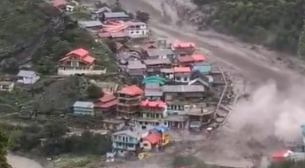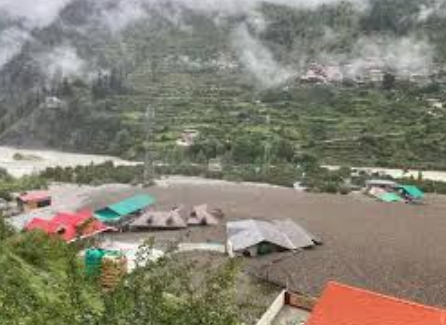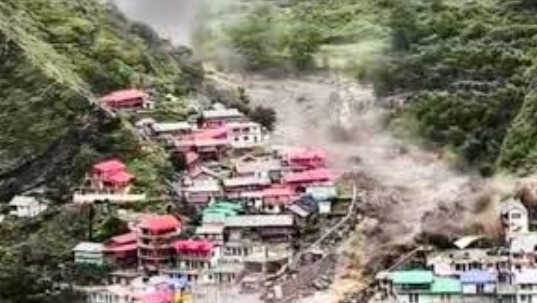Introduction
On the morning of August 5, 2025, a catastrophic natural disaster struck the northern Indian state of Uttarakhand. A violent cloudburst occurred in the upper Himalayan region near Dharali, triggering an intense flash flood that devastated the village and nearby areas. This sudden and extreme weather event brought with it widespread destruction, loss of life, and a stark reminder of the increasing frequency of such disasters in the fragile Himalayan ecosystem.


The Uttarkashi cloudburst has already resulted in multiple deaths, dozens of missing persons, and severe infrastructure damage. Entire houses, shops, and hotels were washed away in a matter of minutes. Rescue teams, including the Army, NDRF, SDRF, and ITBP, were deployed quickly in what is being termed as one of the most critical rescue operation Uttarakhand has seen in recent years. The Uttarkashi flood 2025 is not just a tragedy—it is a warning sign of the dangers looming in climate-sensitive zones like the Himalayas.
This article presents a structured, in-depth overview of what happened, why it happened, and what comes next.
What is a Cloudburst?
A cloudburst is an intense and highly localized rainfall event, where over 100 mm of rain may fall in less than an hour in a small geographic area. This often results in sudden flash floods, especially in mountainous regions where drainage is poor, and slopes amplify water velocity.
Cloudbursts are particularly dangerous in places like Uttarakhand due to the state’s steep terrain, glacial rivers, and human encroachment into ecologically sensitive zones. The latest cloudburst in Uttarakhand was yet another reminder of this growing danger.
Timeline of the Disaster

The events leading to the Dharali disaster unfolded rapidly:
- In the early hours of August 5, 2025, heavy rainfall began over Uttarkashi district.
- Around 3:00 AM, a cloudburst occurred over the Kheer Ganga catchment near Dharali.
- Within minutes, a massive flash flood surged through the village, sweeping away structures on both sides of the river.
- Several areas, including Gangotri and Harsil, reported damage as rivers overflowed and mudslides followed.
- Local residents were caught off guard in their sleep, and many were trapped inside buildings.
- By morning, rescue teams had begun mobilizing, but blocked roads and collapsed bridges delayed access.
The speed at which the water rose left little time for evacuation. Survivors reported terrifying scenes of gushing muddy water carrying away homes, people, and livestock.
The Worst-Hit Areas
The Uttarkashi cloudburst hit multiple locations, but Dharali bore the brunt. The impact zones include:
- Dharali village: More than 20 buildings were completely destroyed, including guest houses and homes.
- Harsil Valley: Several army personnel and civilians went missing as nearby structures collapsed.
- Gangotri National Highway: Severely damaged, cutting off access for tourists and pilgrims.
- Nearby villages: Many smaller settlements were left isolated due to blocked or destroyed routes.
The situation was worsened by additional cloudbursts reported near Sukhi Top later the same day, affecting adjoining catchment areas and further complicating rescue efforts.
Human Impact: Deaths and Missing Persons
Although exact numbers are still being verified, preliminary reports indicate:
- At least four confirmed deaths due to the flash flood.
- Over fifty people missing, including 8–10 Indian Army soldiers stationed near the area.
- Dozens of others injured, some critically, and many still trapped under debris.
- Eyewitnesses believe that the actual number of missing could be even higher.
The confusion over the number of deaths and missing in Uttarkashi stems from communication breakdowns, inaccessibility of certain locations, and the vast spread of the disaster zone.
Families continue to search desperately for loved ones, with many still unaccounted for nearly 24 hours after the event. The riverbanks are being combed inch by inch by search teams.
Infrastructure Damage
The Uttarkashi flood 2025 (Uttarkashi Cloudburst) left behind massive destruction:
- Dozens of homes, hotels, and small commercial establishments were completely swept away.
- Vehicles, including buses and private cars, were either submerged or carried away.
- Several key bridges collapsed, including one near the Harsil helipad, hampering helicopter operations.
- Power lines and water supply pipelines were snapped, leaving affected villages without electricity or clean water.
- Over 160 roads were damaged or blocked by landslides, including critical highways.
Satellite images show large stretches of brown sludge where green forested land once stood. The once-thriving tourist route to Gangotri is now nearly inaccessible.
Rescue Operations Underway
The rescue operation Uttarakhand launched in response has been one of the largest in recent years. Teams involved include:
- Indian Army units, especially the Ibex Brigade stationed nearby.
- NDRF teams, equipped with life-saving tools and boats.
- SDRF and ITBP, providing ground support in difficult terrain.
- Local police and administration, coordinating shelters, food supply, and emergency contacts.
Choppers have been placed on standby, though bad weather and washed-out helipads have delayed air relief. Sniffer dogs, drones, and thermal imaging devices are being used to locate people trapped under mud and debris.
So far, over 130 individuals have been rescued and relocated to relief shelters. Medical teams are also on site, offering treatment to the injured.
Government and Administrative Response
The Uttarakhand government responded swiftly:
- Chief Minister Pushkar Singh Dhami visited the area via aerial survey.
- Emergency funds were released to support local administration.
- Relief camps with food, blankets, and first-aid have been established.
- Local schools and Anganwadis were ordered shut in multiple districts.
- Continuous alerts are being issued through television, radio, and digital platforms.
The central government has assured full cooperation, including disaster relief funding, deployment of forces, and technical support for search and rescue.
Senior IAS officers have been stationed in the region to directly oversee coordination and ensure faster rehabilitation.
Why the Numbers Are Still Unclear
Despite the scale of the disaster, the exact numbers of deaths and missing remain uncertain due to:
- Ongoing rain and fog preventing access to some locations.
- Roads blocked by landslides, delaying rescuers from reaching trapped areas.
- Destruction of mobile towers and communication lines affecting real-time updates.
- Eyewitness reports that remain unverified until official confirmation.
There are reports of entire families missing, but these are being carefully validated by disaster response teams before public release.
Environmental Context: Climate and Construction
Experts have long warned about the risks associated with human interference in ecologically fragile zones. The Dharali disaster was worsened by:
- Unregulated construction near riverbanks and on loose soil.
- Deforestation due to expanding roads and hotels catering to tourism.
- Climate change causing more frequent and intense cloudbursts.
- Glacial melt adding to river volume, increasing flood potential.
This combination of natural and man-made factors turned what could have been a moderate flood into a large-scale tragedy.
Public Reactions and Social Media
Across India, public response to the Uttarakhand flash flood has been one of shock, sympathy, and solidarity.
- Social media flooded with videos showing muddy torrents wiping out homes.
- Hashtags like #UttarkashiFlood, #CloudburstNewsToday, and #PrayForUttarakhand trended for hours.
- Religious leaders, celebrities, and NGOs called for immediate aid and long-term planning.
- Appeals were made for blood donations and volunteering in rescue efforts.
People from nearby districts began arriving with food, clothes, and medicines to help affected families.
Religious Tourism and Economic Impact
The affected region is a key part of the Char Dham Yatra route, especially the road leading to Gangotri. Economic consequences include:
- Suspension of tourism, which supports hundreds of locals through hotels, taxis, shops, and food stalls.
- Damage to religious infrastructure near Gangotri, where pilgrims often stay en route.
- Long-term road repair and construction costs that will take months, if not years.
The Char Dham Yatra has been temporarily suspended to ensure the safety of pilgrims and allow smooth rescue operations.
The Way Forward
The Uttarkashi flood 2025(Uttarkashi Cloudburst) is a wake-up call. Moving ahead, the state and central governments must:
- Invest in better weather forecasting and early warning systems.
- Enforce stricter zoning laws for construction near rivers and hills.
- Conduct regular mock drills and awareness campaigns in high-risk villages.
- Fund climate research to track monsoon and glacial patterns.
- Build more sustainable, eco-friendly infrastructure.
The Himalayas are extremely sensitive to disruption, and continued negligence could lead to worse disasters in the future.
The Uttarkashi cloudburst has once again shown how unprepared we are when nature strikes without warning. This cloudburst in Uttarakhand has not only claimed lives but shattered families, destroyed livelihoods, and left communities in ruins.
But it can also become a turning point. If we respond with accountability, scientific planning, and compassion, we can prevent the next Dharali disaster. Climate change is real, and its consequences are unfolding before our eyes.
